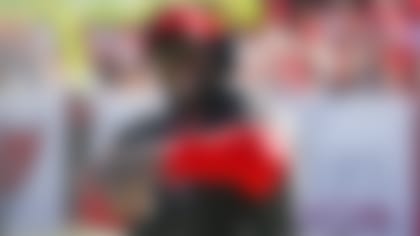The importance of the quarterback position in the NFL is no passing fancy.
It's no coincidence that the No. 1 overall pick has been a quarterback in nine of the past 11 NFL drafts. Not surprisingly, NFL teams threw for more passing yards in 2011 than in any other year in league history.
Casserly: Two-round mock draft
Charley Casserly projects the first two rounds of the 2012 NFL Draft, with no quarterbacks coming off the board in Round 2. **More ...**
It is not expected, however, that six of the top 36 picks will be signal callers like in the 2011 NFL Draft. The fact so many quarterbacks came off the board early last year has diminished the feeding frenzy. More teams this year are looking for solid backups or developmental prospects than immediate starters.
The fabulous talents already pegged as the 2012 draft's top two picks, Stanford's Andrew Luck and Baylor's Robert Griffin III, make this quarterback class memorable. The fact the Washington Redskins sent two future first-round picks (in addition to their current second-rounder) to switch spots with the St. Louis Rams so they can nab one of these two players (likely RG3) is all the evidence you need of their potential.
But the rest of the quarterback class appears to be average. That said, impact players can be found in every round of the draft. Let's take a look at which quarterbacks in the different tiers of this year's class I think will enjoy the most success at the pro level.
Thursday stars
Impact quarterbacks in the first round help their teams contend for championships.
Andrew Luck, Stanford: Scouts have already seen Luck's ability to run a pro-style offense. His size (6-foot-4, 234 pounds), lineage (father, Oliver, was an NFL quarterback and is currently the athletic director at West Virginia) and very good athleticism (4.67 40, 36-inch vertical) make him a complete prospect. Indianapolis will have a difficult time passing on the two-time Heisman Trophy runner-up with the first overall pick.
Robert Griffin III, Baylor: Though Griffin showed promise throughout his Baylor career, he really jumped into the national spotlight with this season-opening performance against TCU; RG3 went 21-for-27 for 359 yards and five touchdowns in the 50-48 win. His stock rose throughout his Heisman-winning junior season. He boasts deft touch on deep passes, and his superior speed (4.41 40 at the NFL Scouting Combine), infectious personality and intelligence only augment his value. The Redskins hope their big investment in Griffin pays off with regular playoff appearances -- and a Super Bowl ring.
Ryan Tannehill, Texas A&M: The wild card in the first round is the draft's third-rated passer. After losing the quarterback battle to Jerrod Johnson as a redshirt freshman, he led the team in receptions for two straight years. During the 2010 campaign, though, he replaced Johnson behind center, leading the team to six straight wins and a bowl berth. His former head coach at A&M, Mike Sherman, is now the offensive coordinator for the Miami Dolphins, so they seem his most likely suitor in the top 10. But other teams may see his potential as an impact starter and trade up ahead of the Dolphins at No. 8. Stay tuned for how this story will play out early on Thursday evening of draft weekend.
Friday night lights
Impact quarterbacks in the second and third rounds are probable starters who can lead a team to the playoffs with a strong surrounding cast.
Reuter: Who'll be the better pro?
Andrew Luck vs. Robert Griffin III. Justin Blackmon vs. Michael Floyd. Chad Reuter examines two big debates in the 2012 draft. **More ...**
Brandon Weeden, Oklahoma State: Weeden will likely be the first quarterback off the board Friday, because of his ability to sling the ball accurately from the pocket. His advanced age (he turns 29 in October) and shoulder injury from his minor league baseball pitching days may scare off teams from selecting him in the first round, but in today's win-now NFL, coaches can't necessarily wait three years for a younger second- or third-round quarterback to mature physically and mentally before making an impact.
Brock Osweiler, Arizona State: His 6-foot-7 frame and inexperience (15 career starts, 7-8 record) worry teams, but the arm strength and better-than-expected agility for his size may land the Sun Devils' first 4,000-yard passer a second- or third-round selection. It could take time for Osweiler to get on the field no matter who takes him, so his best fit might be behind a veteran pocket passer who can teach him the ropes. (Peyton Manning in Denver, possibly?) If he proves to be a good learner, his impact -- though delayed -- could be real.
Saturday sleepers
Impact quarterbacks from rounds four through seven may become regular starters, but should at least be reliable backups and spot starters.
Russell Wilson, Wisconsin: Wilson helped Wisconsin reach the Rose Bowl after transferring from North Carolina State for his senior season, due to Wolfpack coach Tom O'Brien's concerns about his moonlighting as a minor league baseball player in the Colorado Rockies' system. Measuring under 5-11 limits Wilson's upside a bit, and his consistency from the pocket has been questioned, so he'll probably last until the fourth round. But his poise and mobility should make him a locker room favorite and give teams at least a reliable backup -- something many teams don't have right now.
Nick Foles, Arizona: Foles' 6-5, 243-pound frame allows him to see the field and distribute the ball from the pocket. His lack of mobility and inconsistency makes him a third-day prospect, but don't be surprised if he succeeds as a starter or solid option off the bench given more reliable receivers than he played with in Tucson and a line capable of protecting him.
B.J. Coleman, Chattanooga: This Tennessee transfer has the requisite physical attributes (6-3, 233 pounds) to contribute at the next level, and the way the ball comes out of his hand grabbed the attention of scouts throughout the week of the East-West Shrine Game. If he proves mature enough to take coaching and plays with more calm and poise in the pocket, Coleman could develop into a viable option in the right circumstances.
Follow Chad Reuter on Twitter @ChadReuter




